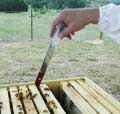As beekeepers we employ a variety of tools. Smoker, Hive tool, frame holders, etc etc. When I prepared the Honey Bee Health Coalition guide on managing varroa we called the guide a tool – an educational aid to combat our most serious bee pest.
Just a few decades ago, tool use was among the traits said to “make us human” — but that’s now problematic, both because it turns out tool use isn’t so unique meaning that humanity’s most treasured qualities (tool use/language, etc) are not necessarily unique to humans.
Skunks can be added to the list of non-human animals that use tools. On a cold winter night Suzanne Dickerson (twitter @CameraTrapSue) photographed a striped skunk in her suburban Colorado Springs backyard carrying a stone in one paw. The skunk climbed onto a water bowl and, using the stone like a hammer, banged a hole in its frozen surface.
Previously tool use has been described in many of our closest animal kingdom relatives, the primates, as well as in a host of birds (crows, ravens, woodpeckers), even for fish that use shellfish to construct an egg-laying site and octopi who construct coconut shell hideouts.
Many beekeepers are familiar with the chimpanzees of Jane Goodell or those of Gabon using sticks on underground bee nests (https://theconversation.com/chimpanzees-hunting-for-honey-are-cleverer-than-we-thought-74379). Bonobos, gorillas, baboons and even orangutans fashion a similar stick to obtain honey and brood from aerial nests (as do human such as for example as has been documented for the pygmies of the Congo). Their harvest is not as sophisticated as our current method – simply push a stick into a nest, move it about and then remove it with its clinging honey/brood.
Although uncommon (less than 1% of other animals have been shown to use tools) humans seem to “love” fiddling with objects in order to solve a problem that captures our gadget-loving imaginations.
The tool (rock) carrying skunk was not the discovery of a scientist but by a citizen using her tool (motion activated camera) in her backyard. This activity is often labelled citizen science. Beekeepers have been invited to participate in data collection in their own backyard in citizen science projects — natural scientists at work. Oftentimes they can really advance our understanding of our world as in this new example of skunks using tools.
Source: Pesendorfer et al., “Observation of tool use in striped skunks: how community science and social media help document rare natural phenomena.” Ecosphere, 2018.

